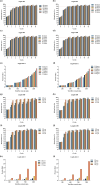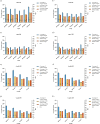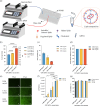Optimizing Microfluidic Channel Design with Tilted Rectangular Baffles for Enhanced mRNA-Lipid Nanoparticle Preparation
- PMID: 40396945
- PMCID: PMC12221266
- DOI: 10.1021/acsbiomaterials.4c02373
Optimizing Microfluidic Channel Design with Tilted Rectangular Baffles for Enhanced mRNA-Lipid Nanoparticle Preparation
Abstract
RNA therapeutics represent a pivotal advancement in contemporary medicine, pioneering innovative treatments in oncology and vaccine production. The inherent instability of RNA and its delivery challenges necessitate the use of lipid-based nanoparticles as crucial transport vehicles. This research focuses on the design, simulation, and optimization of various microfluidic channel configurations for fabricating poly(dimethylsiloxane) (PDMS) microfluidic chips, aimed at producing lipid nanoparticles (LNPs) encapsulating green fluorescent protein mRNA (GFP mRNA). Aiming for high mixing efficiency and acceptable pressure drop suitable for scale-up, we designed and improved multiple microfluidic channels featuring flow focusing and diverse tilted rectangular baffle structures via computational fluid dynamics (CFD). Simulation results indicated that baffle angles ranging from 70 to 90° exhibited similar mixing efficiencies at different total flow rates, with pressure drops increasing alongside the baffle angle. Additionally, increasing the baffle length at a fixed angle of 70° not only improved mixing efficiency but also increased the pressure drop. To validate these findings, PDMS microfluidic chips were fabricated for all designs to prepare empty LNPs. The baffle structure with a 70° angle and 150 μm length was identified as the best configuration based on both simulation and experimental results. This optimal design was then used to prepare LNPs with varying GFP mRNA concentrations, demonstrating that an N/P ratio of 5.6 yielded the highest transfection efficiency from in vitro experiments. This work not only advances the production of lipid-based nanoparticles through microfluidics but also provides a scalable and reproducible method that can potentially enhance the clinical translation of RNA therapeutics.
Keywords: CFD simulations; lipid nanoparticles; microfluidic; transfection.
Figures




References
-
- Huang X., Ding Y., Gu J., Tao Y., Wu X., Luo Q., Li Y., Cai X., Chen Z.. Organ-selective lipid nanoparticles for precise cancer therapy: Beyond liposomes and polymeric micelles. Chem. Eng. J. 2024;494:153171. doi: 10.1016/j.cej.2024.153171. - DOI
MeSH terms
Substances
LinkOut - more resources
Full Text Sources
Miscellaneous
